John Haltigan (1819 - 1884)
and sons James & Patrick
Irish & American Patriots
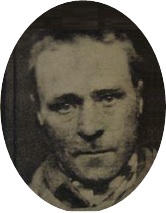 John Haltigan was a prominent figure in the Irish nationalist
revolutionary movement in the two decades following the collapse of
the “Young Irelander” 1848-49 revolution and the ending of the
terrible famine in Ireland. He was one of the founding members of
the Irish Republican Brotherhood (IRB) and devoted his entire life
to the struggle for Irish independence, including internment under
harsh conditions in English prisons for three and one half years.
The IRB was the Irish counterpart to the US based Fenian
Brotherhood, a secret oath based organization, created to fight for
Ireland’s independence from British rule. John O’Mahony the founder
of the Fenian Brotherhood in the U.S. was a Gaelic scholar and he
took the name after the “Fianna,” mythical warriors in ancient
Ireland who lived apart from society and could be called upon in
time of war. Soon both wings were to be characterized as the
“Fenian” Movement, and members “Fenians.”
John Haltigan was a prominent figure in the Irish nationalist
revolutionary movement in the two decades following the collapse of
the “Young Irelander” 1848-49 revolution and the ending of the
terrible famine in Ireland. He was one of the founding members of
the Irish Republican Brotherhood (IRB) and devoted his entire life
to the struggle for Irish independence, including internment under
harsh conditions in English prisons for three and one half years.
The IRB was the Irish counterpart to the US based Fenian
Brotherhood, a secret oath based organization, created to fight for
Ireland’s independence from British rule. John O’Mahony the founder
of the Fenian Brotherhood in the U.S. was a Gaelic scholar and he
took the name after the “Fianna,” mythical warriors in ancient
Ireland who lived apart from society and could be called upon in
time of war. Soon both wings were to be characterized as the
“Fenian” Movement, and members “Fenians.”
John
was born on April 23, 1819 in the city of Kilkenny, County Kilkenny,
Ireland. Family records show his father James was an Irish born
soldier serving in the English army, and his mother Margaret
Haltigan (nee Jackman), a native of Manchester, England. Baptismal
records from St. Mary’s parish church in Kilkenny show that during
the 1820’s and 1830’s John lived with his family of five brothers
and four sisters on a small farm type of residence on Upper Patrick
Street in Kilkenny.
Little information is known concerning John’s formative and teen
age years growing up in the “marble city”. At some point, he was
apprenticed to the printing trade and learned the craft that his
sons and grandsons in America were also to follow in. In 1845 at the
age of 26, he married Catherine Keating, a Kilkenny native also 26
years old. A son James was born in 1847 and another son John in
1849. Throughout his life John was to maintain a very close
connection to his eldest son James, who also followed in his
father’s footsteps, learning the printing trade. As will be seen,
James although from the shores of America, made many significant
contributions of his own to the cause of Irish independence and
Irish-American history.
At
the 1850 mid-century point, John was 30 years old and married with
two children. Dark days were upon Ireland with the terrible famine
at its height and the “Young Irelander” 1848/49 revolutionary
movement to free Ireland from British rule having been a dismal
failure. There is some evidence such as census reports and ship
manifests that suggest that his brothers Thomas and James and/or
their young sons may have immigrated to America around this time.
John himself however maintained a stable life with his family,
having risen through the ranks and was employed as a foreman printer
for the Kilkenny Journal newspaper. Denieffe,
in his book Recollections of the Irish
Revolutionary Brotherhood, states that in his visit to
Kilkenny in 1855, he found John “in good circumstances owning a nice
little farm on the borders of the town. His wife, like himself was
a good sincere nationalist, whose counsel infused prudence and
courage into many. He had two fine greyhounds and we went hunting
every Sunday to the Tullaburn mountains where he knew a great many
men of the right stamp, all of whom he initiated into our movement.”
Although the Young Irelander movement and the revolutionary
activity of 1848-49 to rid Ireland of English rule did not achieve
its goal of an Irish Republic, there is no question that John as a
young man in his late twenties was well aware of and absorbed the
revolutionary, nationalist writings and speeches of legendary Irish
leaders of the era, Francis Meagher, Devin Reilly, John Mitchel,
Smith O’Brien and others in The Nation newspaper and
elsewhere. Dr. Robert Cane as well as James Stephens, both Kilkenny
natives were associates of his and had played minor roles in the
1848 uprising. Young Irelander veteran and fellow Fenian, John
Savage in his 1868 book, Fenian Heroes and Martyrs
states that “Haltigan identified himself with Irish nationality from
youth.”
Of
upmost significance for the future however, a New York City based
tailor named Joseph Denieffe, a strong Irish Nationalist was also a
native of Kilkenny. In the summer of 1855 journeyed to Ireland as a
representative of the Emmet Monument Association (EMA). The EMA was
an American organization of mostly Irish immigrants sworn to fight
for Ireland’s independence. Michael Doheny, John O’Mahony, and
Michael Corcoran were the principle organizers. The EMA would
evolve several years later into the Fenian Brotherhood.
Denieffe’s mission on behalf of the EMA was to establish contacts in
Ireland, build up nationalist sentiment and prepare and lay the
groundwork for what was expected to be an early movement by the EMA
to invade and liberate Ireland from the British. No such movement
took place, but Denieffe’s trip was the real beginning of an
organized effort to revitalize and spread the revolutionary movement
in Ireland. Denieffe first visited his hometown city and then met
with John Haltigan, who in turn introduced him to Dr. Cane and many
other nationalists in Kilkenny and nearby Callan. He later made
arrangements and provided information for Denieffe to establish
contacts and meet with many nationalists in Dublin. This early
groundwork provided by Haltigan and others would result in the
founding on St. Patrick’s day in 1858 of the Irish Republican
Brotherhood (IRB) under the leadership of James Stephens, a native
of Kilkenny who had returned from Europe.
Following the founding of the IRB the recruitment of members began
in earnest and the oath bound secret brotherhood of individual cells
was built up throughout Ireland. John Haltigan, now approaching
forty years of age, was appointed “Head Centre” for Kilkenny and was
very active in recruiting members, working for the Kilkenny Journal
and responsible for a household that as of January 1859 now included
five children. A daughter Elizabeth (Bessie) had been born in July
of 1853, a third son Thomas in July of 1856 and a forth son Andrew
was born in January of 1859. It is noted that at the baptism of his
daughter Elizabeth in July of 1853 the sponsors were John’s sister
in-law Mary Keating and Patrick Nowlan. Patrick Nowlan, a cooper,
was a very active IRB member from Kilkenny. A son, James Nowlan
later was for over twenty years president of the Gaelic Athletic
Association (GAA) and today the GAA stadium in Kilkenny, Nowlan Park
is named for him.
In his
role as the Head Centre for the Kilkenny region and as a close
associate of IRB leader James Stephens, John Haltigan was actively
involved in an event in November 1861 that was to be a major factor
in the growth of the IRB and that galvanized nationalist
revolutionary sentiment throughout Ireland. The event was the
funeral of Terence Bellew MacManus, one of the 1848 leaders whose
body had been shipped home for burial from California. Stephens
organized a funeral procession, despite the opposition of
disapproving British officials as well as high clergy of the
Catholic church, drew a crowd of over 25,000 people in a rainstorm
who followed the coffin through the streets of Dublin to Glasnevin
cemetery. John Haltigan served as one of the four honorary
pallbearers.
In the
fall of 1863 James Stephens made the crucial decision to go public
and he established in Dublin the weekly nationalist newspaper
The Irish People, hoping it would serve a role much as
The Nation newspaper had done in the mid 1840’s in
promoting the nationalist cause. Legendary names in Irish history
became associated with the newspaper. Thomas Luby was listed as the
registered proprietor. Luby, John O’Leary and Charles Kickham
served as joint editors. Jeremiah O’Donavan Rossa was listed as
publisher and business manager and James O’Connor as bookkeeper.
John Haltigan was the foreman printer for The Irish People.
John moved to a boarding house in Dublin, and brought his son James
just 16 years old to work also as a printer on the paper as well as
several other members of the IRB cell from Kilkenny. He was in
receipt of a yearly salary for his work as a printer as well as IRB
work entailing travel outside of Dublin. The American civil war was
in its third year and just days after President Lincoln’s Gettysburg
address, the first edition of the weekly Irish People
was issued on November 28, 1863.
Along
with his job at the newspaper, Haltigan took on the secondary role
of organizing and overseeing the drilling and training of IRB
recruits from the Dublin area. John Rutherford in his
1877 book The Secret History of the Fenian Conspiracy
states “Haltigan superintended the drilling of the brotherhood in
Dublin and used to beard the police in the observance of these
doings with consummate audacity and insolence.” In November of
1864 a report from the Dublin Metropolitan Police office based on
testimony from an informant reported “Haltigan, one of the staff of
The Irish People reported to Stephens that there was a
policeman watching their drill room at Halston Street and
consequently they deemed it advisable to change and they took
another place in Island Street where he observed the same policemen
watching them there also. Stephens appeared much annoyed about this
and ordered Haltigan to have the knife used upon the policeman but
not to attempt using it himself as they could not afford to lose
such a man.”
As the
months rolled by the articles in The Irish People became more
strident and provocative. The British authorities in Dublin Castle
became more and more concerned and finally with information provided
by informers raided the office of the newspaper on the night of
September 14, 1865 and arrested all the leaders they could including
Haltigan, on charges of treason-felony. In the weeks and months that
followed many other Fenian activists were arrested including famed
journalist and poet John Boyle O’Reilly, and a young John Devoy, who
in later years from his base in America, would prove to be one of
the most prominent as well as the most effective of the exiled rebel
leaders. On November 27, 1865 in Dublin a British Special
Commission was established for the trial of Thomas Clarke Luby, John
O’Leary, Michael Moore, O’Donavan Rossa and John Haltigan for
Treason-Felony, “The Fenian Conspiracy”. Chief counsel for the
defense was the noted Irish barrister Isaac Butt.
The
verdict reached in Dublin on December 8, 1865 in the Queen vs. John
Haltigan was announced as follows:
Clerk
of the Crown – “John Haltigan, you have been tried for feloniously
compassing to depose the Queen, and to compel her majesty to change
her measures, and also to move and stir up foreigners and strangers
to invade Ireland. What have you to say why judgment should not be
pronounced on you by the Court?”
Prisoner Haltigan – “I have nothing to say my lords”.
Mr.
Justice Fitzgerald – “The jury has now found you guilty, and I am
bound to say that in that verdict of guilty I concur. It now
becomes my painful duty to announce to you the sentence of the law,
and it is especially painful in your case, because in the course of
it, we have learned that you have a wife and seven children; and it
is much to be lamented that, when engaging in this criminal and
wicked conspiracy, you did not reflect that in case of your being
brought to punishment for it, the real suffers would be your wife
and children. ------ We recollect too, that you were one of those
who were constantly attending the drillings that were going on; and
taking all of the circumstances into account, we do not think,
wishing as we do to be light upon you, that we should be doing our
duty toward the country in imposing a less sentence than that you be
kept in penal servitude for a term of seven years.”
Fellow
Fenian John Savage in his book Fenian Heroes and
Martyrs states that when the verdict was announced “
Haltigan turned around, leaned over the edge of the dock and kissed
his son who stood near him - a lad of about sixteen years of
age,(18) the eldest of a family of nine - and then he left the dock.
John
Haltigan was to be confined under harsh conditions in British
prisons at Portland and Pentonville, England. While he was at
Pentonville, an Irish nationalist from Cork Jerome Collins was
working as a civil engineer for a construction firm doing work at
the prison. Collins soon learned of the location of the Fenian
cells and was plotting an escape attempt but the plot was discovered
and Collins was forced to flee to America. Collins later became the
founder in the summer of 1867 of the Clan na Gael (Band of the
Irish) the successor organization to the Fenians in America, and
like them committed to the forceful overthrow of British rule in
Ireland. John’s son James would play a prominent role in the Clan na
Gael in America, including serving as its president in 1870.
Following the raid on The Irish People, IRB leader
Stephens after a brief arrest escaped and soon fled Ireland. The
suspension of habeas corpus, the arrest of numerous leaders, poor
planning and the infiltration of numerous informers sent the IRB
into decline. In February and March of 1867, armed revolts by IRB
members in several cities including Cork, Limerick and Dublin were
quickly put down. When Thomas J. Kelly who had replaced Stephens
was arrested in Manchester, England an effort to rescue him was
successful but in the escape a British police officer was killed.
As a result three IRB members, William Allen, Michael Larkin and
Michael O’Brien were convicted for the crime and publicly hanged in
Manchester on November 23, 1867.
Partly as a result of the wide negative backlash surrounding the
“Manchester Martyrs” and also the pleas of the Amnesty Association
under Issac Butt, the British began early release of many of the
convicted IRB members. On March 4, 1869 John Haltigan, Kickham,
O’Connor and several others were given early release. Haltigan, who
was now 50 years old, had spent almost exactly three and one half
years in confinement. Marcus Burke relates that following the
release “In Ireland tumultuous welcomes, marked by defiant and
unrepentant speeches particularly by Kickham were the order of the
day. On March 15, (1869) Kickham and Haltigan arrived in Kilkenny
to find thousands packing the streets of the city which was the
birthplace of the founder of the IRB.” Following his release, John
now 50 years old, returned to his home and wife Catherine and seven
children in Kilkenny. Support for many of the families of imprisoned
Fenians came from family and friends, and Catherine was very
probably helped in the 1865-69 years in this way, while her husband
was confined. Conditions in British prisons, especially for the
Fenians, could be extremely harsh, and there is some indications,
even referenced on the epitaph on his tombstone, that John was
suffering from health issues brought on or acerbated by the
conditions he was forced to endure in prison.
It is around the 1872 time frame that John Haltigan left Kilkenny and came to New York to be with his
son. James as the editor and publisher, started his own weekly
Irish-American newspaper The Sunday Citizen with his
father helping as chief printer and advisor. In 1877, after close
to five years in America, John Haltigan returned to Ireland.
Upon returning to Ireland John worked for several years
as a printer for the Cork Examiner newspaper. He died
in Cork City on July 10, 1884 at the age of 66. The Irish
Canadian Newspaper reported that his body was escorted
back by train by the Nationalists of Cork and members of the
Typographical Society to his native city to be buried in St.
Patrick’s cemetery. St. Patrick’s Brass Band of Kilkenny proceeded
the cortege through the principal streets and at the conclusion of
the funeral ceremonies assembled at the grave and played “God Save
Ireland.” The chief mourners who followed the remains were his sons
John, Andrew, Patrick and son in law Timothy Lalor.
On
July 12, 1884 the Kilkenny Journal reported the
following: Death
of Mr. John Haltigan
“Many
of the old citizens will hear with regret of the death of Mr. John
Haltigan, which occurred on the 10th instant in Cork,
where he had been for many years connected with the Cork
Examiner. Mr. Haltigan who for a long period was foreman in
the Journal Office, took a prominent part in the “67 Movement, and
at the celebrated state trials, was with James Stephens, Charles
Kickham and the other leaders, sentenced to penal servitude. He was
released on the first amnesty, and proceeded to America, where his
son occupies a highly respectable position on the American Press,
being editor and proprietor of one of the leading journals. Mr.
Haltigan was deservedly esteemed by the leaders of 67 for his
thorough honesty of purpose and fidelity to the cause. May he rest
in peace.”
On
July 19, 1884 the Journal reported that “On Thursday evening last a
circular-convened meeting of the trades of this city was held in the
Athenaeum for the purpose of furthering the very laudable object of
the erection of a monument over the grave of the late Mr. Haltigan,
whose unflinching and uncompromising conduct in connection with the
67 movement secured for him a place in the hearts of the people,
which none other than a self-sacrificing love of country could have
won for him.” In Kilkenny city there is a street that is named in honor of John,
called Haltigan Terrace.
---------------------------------------------------------------------------------------------
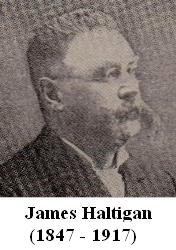 John’
son James who was with him as a printer on for the Irish People and
was with him in the court room when he was sentenced had fled to
America. John Savage in his book Finian Heroes and Martyrs
states the following: “The son true to the principles for which his
father was exiled - true to the promise made to him in the dock -
was indefatigable in his exertions to extend the organization. He
traveled throughout the country with messages from the Chief, and in
turn was subjected to the vigilance of the police. On the suspension
of the Habeas Corpus Act he had to secrete himself, and came to
America in the winter of 1866-67.”
John’
son James who was with him as a printer on for the Irish People and
was with him in the court room when he was sentenced had fled to
America. John Savage in his book Finian Heroes and Martyrs
states the following: “The son true to the principles for which his
father was exiled - true to the promise made to him in the dock -
was indefatigable in his exertions to extend the organization. He
traveled throughout the country with messages from the Chief, and in
turn was subjected to the vigilance of the police. On the suspension
of the Habeas Corpus Act he had to secrete himself, and came to
America in the winter of 1866-67.”
James
would have been 19 years old when he fled to America, settling in
New York City, seeking work as a printer in the newspaper business
for which he was trained. He was accepted by Typographical Union
#6, the forerunner of what became known in the printing union as
“The Big Six”. It should be noted that the younger brothers of
James, Thomas and Andrew both also later came to America and worked
for the Big 6 union. Another brother John worked for the union in
Dublin and youngest brother Patrick Haltigan also held a printers
union card in Washington, DC. James first worked for the New
York Evening Globe where he became active in union affairs
and was elected president of the Chapel (union local) before
transferring to the Daily News. He continued to be
deeply involved in Irish and Irish-American affairs and according to
William D’Arcy in his The Fenian Movement in the
United States 1858-1886 was President of the secret Clan na
Gael organization in 187 James
next turned his attention to what was to become one of his most
enduring legacies, as the editor and publisher of the first
Irish-American literary magazine. The Illustrated Celtic
Monthly, An Irish American Magazine Devoted to Literature, Music,
the Drama and the Arts and Current Affairs was
launched in 1879 and was to last until 1884 when because of lack of
funding it ceased publication. It was a publication both designed to
promote Ireland’s rich literary heritage and also to promote the
cause of Irish independence. The writings and poetry of many
Irish-American literary figures of the time to include John Boyle
O’Reilly, John Locke, John Savage and Patrick Cassidy were published
in the magazine.
When
the Illustrated Celtic Monthly folded, James returned
to the printing trade and in 1890 took a job with the New York
World newspaper. He worked at the World for over twenty
years, being very active in union affairs, serving as the Chairman
of the Chapel for fifteen years, while at the same time remaining
very active in Irish and Irish-American political affairs. Perhaps
the greatest legacy of James Haltigan was his writing of the book,
The Irish in the American Revolution and Their
Early Influence in the Colonies The book of over 600 pages
was illustrated and was published in 1907. Although sometimes
labeled as an example of Hibernocentrism, the book was extensively
researched and did counter some of the anti-Irish sentiment that was
prevalent at the turn of the century. It is still available and
referenced today. Several years after retiring from The
World, James died on October 23, 1917 leaving his wife,
the former Maria Kitson, sons John and Robert and a daughter Bessie.
He is buried in St, Joseph’s cemetery in Yonkers, New York.
---------------------------------------------------------------------------------------------
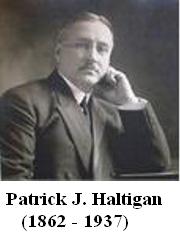 John
Haltigan’s youngest son Patrick, was twenty when in 1880 he
immigrated to America working first also as a printer for seven
years in New York City before moving to Washington to work in the
Government Printing Office.
John
Haltigan’s youngest son Patrick, was twenty when in 1880 he
immigrated to America working first also as a printer for seven
years in New York City before moving to Washington to work in the
Government Printing Office.
He obtained a law degree from Georgetown
University and in 1911 was appointed by Democratic Speaker of the
House Champ Clark as Reading Clerk of the House of Representatives,
a post he held until 1936. On April 6, 1917, he called the roll of
members on the resolution declaring war on Germany. He also served
as the reading clerk calling the roll of the states at four separate
Democratic National Conventions.
Patrick was also very active in
Irish-American affairs and from 1901 until 1915 he served as the
editor and publisher of the Hibernian Digest, the
journal of the Ancient Order of Hibernians, (AOH) the largest
Catholic Irish fraternal organization. In his national role as an
official with the AOH, he was instrumental in helping to erect the
statute to Revolutionary Naval Officer Commodore John Barry in
Washington, D.C. On behalf of his achievements and those of his
father, Patrick was presented with the “freedom” (key) to the city
of Kilkenny by the city council when he visited his native city in
August of 1925. Patrick J. Haltigan died on July 8, 1937 and
was buried in Mt. Olivet cemetery in Washington, D C under a large
Celtic Cross tombstone similar to his father.
Contributor:
John Haltigan
cemetery
AND
grave
location
Name:
St.
Patrick's Graveyard,
PHONE
NO. 056
7764400
ADDRESS: Patrick
Street Upper, Kilkenny, Co. Kilkenny, Ireland
HEADSTONE & INSCRIPTION
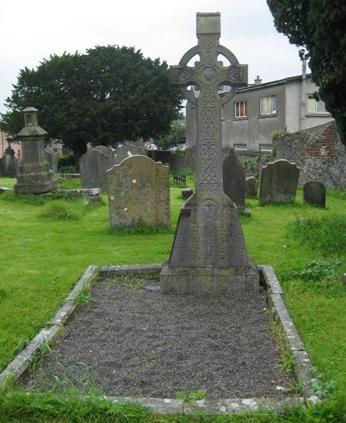
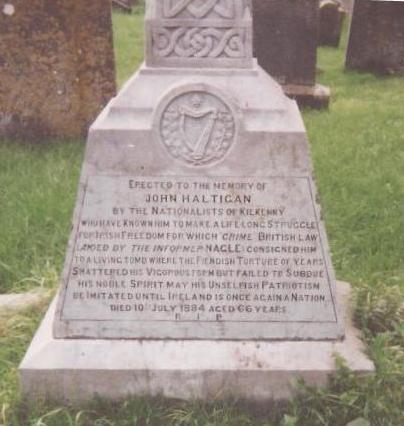
A
large Celtic cross was erected at the grave of John Haltigan and the
inscription on the large base reads as follows:
Erected to the memory of John Haltigan by the Nationalists of
Kilkenny who have known him to make a lifelong struggle for
Ireland’s freedom for which crime British law, aided by the informer
Nagle, consigned him to a living tomb where the fiendish torture of
years shattered his vigorous form but failed to subdue his noble
spirit. May his unselfish patriotism be imitated until Ireland is
once again a Nation.
John’s
wife Catherine, who died in January of 1899, is buried with him.
Back to Biographies
Posted 2/28/2015